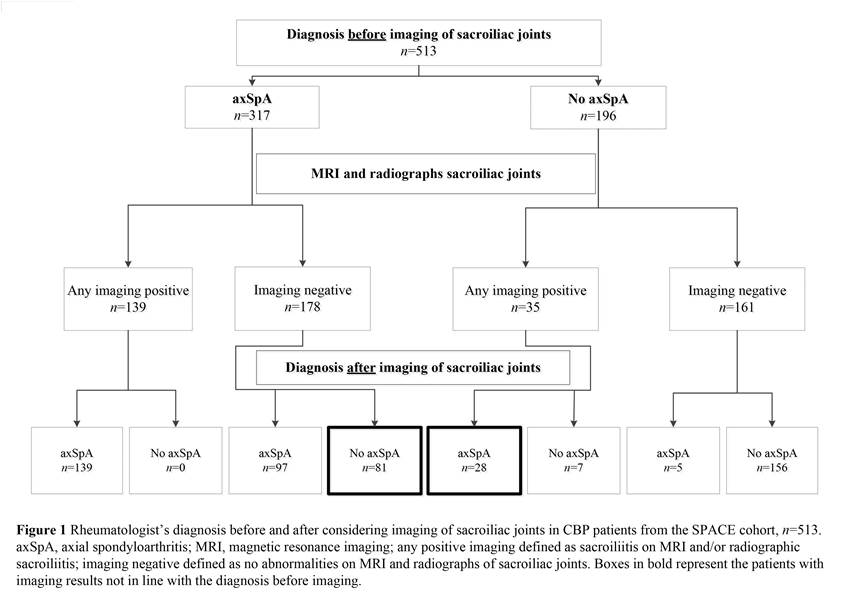Session Information
Date: Monday, November 6, 2017
Title: Spondyloarthropathies and Psoriatic Arthritis – Clinical Aspects and Treatment Poster II
Session Type: ACR Poster Session B
Session Time: 9:00AM-11:00AM
Background/Purpose:
Imaging of the sacroiliac joints plays a pivotal role in the recognition of axSpA. However, interpretation of imaging is challenging and has led to concerns of overreliance on imaging possibly leading to incorrect diagnoses of axSpA. Given these controversies, surprisingly little is known about how rheumatologists actually integrate sacroiliac imaging results in the diagnostic work-up of patients suspected of axSpA. Therefore, we evaluated the influence of sacroiliac imaging on diagnosis and rheumatologists’ confidence in diagnosis of patients with chronic back pain (CBP) suspected of early axSpA.
Methods:
Baseline data from 513 patients from the SPACE cohort which includes patients with CBP (≥3 months, ≤2 years, onset <45 years) were analysed. All patients underwent a full work-up including MRI and radiography of the sacroiliac joints. Rheumatologists were asked to provide a diagnosis before and after taking imaging into account. Also, a level of confidence (LoC) regarding the diagnosis on an 11-point numerical scale (0: not confident at all to 10: very confident) was documented.
Results:
Before imaging, 317/513 (62%) CBP patients were diagnosed with axSpA. Of these patients, 178/317 (56%) did not have sacroiliitis on MRI or radiography, and after imaging rheumatologists changed diagnosis to ‘no axSpA’ in 81/178 (46%) patients. Of the patients without axSpA before imaging, 35/196 (18%) had sacroiliitis on imaging. After imaging, 28/35 (80%) patients were diagnosed with axSpA and in 7/35 (20%) patients the diagnosis remained ‘no axSpA’ In general, diagnostic confidence increased significantly following imaging (all patients’ average LoC 6.2 to 7.4, p<0.001). Overall, imaging results not in line with the diagnosis (n=213) before imaging led to a change in diagnosis in 109 (51%) patients.
Conclusion:
In CBP patients suspected of axSpA sacroiliac imaging increases diagnostic confidence. However, the number of changes in diagnosis suggests that imaging is an important but not the all-decisive factor in axSpA diagnosis.
To cite this abstract in AMA style:
Ez-Zaitouni Z, Landewé RBM, van Lunteren M, Bakker P, Fagerli KM, Ramonda R, Jacobsson LT, van der Heijde D, van Gaalen F. Is Sacroiliac Imaging the All-Decisive Factor in the Diagnosis of Early Axial Spondyloarthritis? Data from the Spondyloarthritis Caught Early (SPACE) Cohort [abstract]. Arthritis Rheumatol. 2017; 69 (suppl 10). https://acrabstracts.org/abstract/is-sacroiliac-imaging-the-all-decisive-factor-in-the-diagnosis-of-early-axial-spondyloarthritis-data-from-the-spondyloarthritis-caught-early-space-cohort/. Accessed .« Back to 2017 ACR/ARHP Annual Meeting
ACR Meeting Abstracts - https://acrabstracts.org/abstract/is-sacroiliac-imaging-the-all-decisive-factor-in-the-diagnosis-of-early-axial-spondyloarthritis-data-from-the-spondyloarthritis-caught-early-space-cohort/

